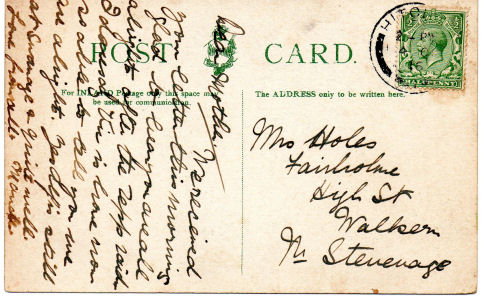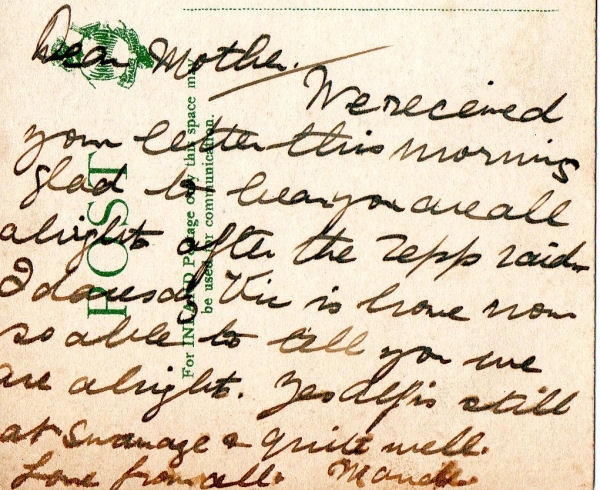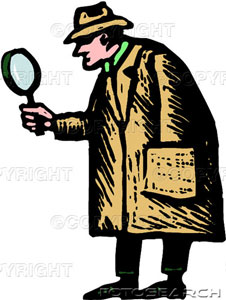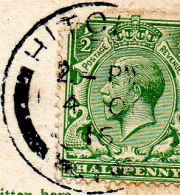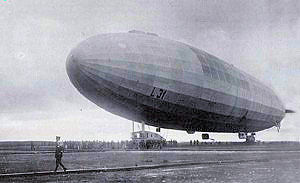|
|
Zeppelins, Walkern, October 1916 May, 2011 |
|
|||||||
|
|||||||||
Fist a brief introduction on the Zeppelin raids of 1916.
To avoid being shot at from the ground the raids were normally at night - with a new moon - and they flew high. The noise of their engines could clearly be heard on the ground but they were hard to see beyond a shadow blocking out a few stars. A network of observers on the ground listened for them and phoned their positions so that the nearby towns and villages could be blacked out. It is clear from surviving records that we had little idea how much detail they could see on the ground - while they often had very little idea where they were. German records record "successful" bombing raids where it is known from British sources that they fell in uninhabited areas miles from where the Germans had thought they were. In addition to bombing targets some of the more rural bombs might have been dropped as ballast in order to gain more height. There was strict censorship and the British press were forbidden from reporting details of bombing raids.
 When
I wrote the book
The London Gunners come to Town I looked at
the Zeppelin raids that flew over West Hertfordshire, and I also wrote a
booklet
The Tring Zeppelin which discussed the history of the
L.32. which passed over Tring on the night of 2/3rd September 1916 - when
the first German raider was shot down. The map shows the approximate
routes taken by the attacking airships - the Zeppelins L.16 and L.31 and the
fated Schütte-Lanz 11.
When
I wrote the book
The London Gunners come to Town I looked at
the Zeppelin raids that flew over West Hertfordshire, and I also wrote a
booklet
The Tring Zeppelin which discussed the history of the
L.32. which passed over Tring on the night of 2/3rd September 1916 - when
the first German raider was shot down. The map shows the approximate
routes taken by the attacking airships - the Zeppelins L.16 and L.31 and the
fated Schütte-Lanz 11.
The information for this map came from the books Joseph Morris's The German Air Raids in Great Britain (London, 1925) and the official war history, H A Jones' The War in the Air, Volumes 2, 3 & 5 (Oxford, 1928-1935). It would seem that the L.16 probably passed to the north of Walkern at the start of the attack. On seeing the SL.11 going down in flames the ship turned east and unloaded most of its bombs on Essendon. It then fled north and the map shows an additional bomb which can't have been that far from Walkern.
So could this bomb be the "Zepp raid" mentioned in the card? To find out we need to know more about when and why it was sent - which means knowing more about who sent it.
It was posted on the 4th October, a month after the Zeppelin raid of 2/3 September - and if Mrs Moles had been "at risk" at the beginning of September one might expect a quick exchange of reassurances. However further raids took place at the next new moon and some of the Zeppelins may have flown over the eastern half of Hertfordshire. Looking at Wikipedia we find that the L31 almost certainly passed near Walkern on 1st October, 1916:
The next raid came on 1 October 1916. Eleven Zeppelins were launched at targets in the Midlands and at London. As usual weather played a major role and only L.31 under the experienced Heinrich Mathy, on his fifteenth raid, reached London. Approaching from Suffolk, L.31 was picked up by the searchlights at Kelvedon Hatch around 21:45; turning away, the craft detoured over Harlow, Stevenage and Hatfield before cutting its engines and drifting with the wind over Hertford. As the airship neared Cheshunt at about 23:20 the engines were restarted and the craft was quickly picked up by six searchlights. Three aircraft of No. 39 Squadron were in the air and closed on L.31. Mathy ordered the dumping of bombs, (fifty fell on Cheshunt), in order to gain altitude. A BE2c piloted by 2nd lieutenant Wulstan Tempest engaged the Zeppelin around 23:50; three bursts were sufficient to set L.31 ablaze and it crashed near Potters Bar with all nineteen crew dying – although again many decided to jump rather than burn (including Mathy, whose body was found near the wreckage, embedded some four inches in the softened earth). Tempest had had to dive out of the way of the stricken craft and, over-wrought, had crashed on landing, suffering minor injuries.
It seems virtually certain that the "Zepp raid" referred to on the post card related to the final flight of the Zeppelin L31 on the night of October 1st,
More can be learnt by asking who sent the card. I checked the census returns over several decades (on Find My Past) and civil registration (FreeBMD). The card was sent to Mary Ann Holes, who in 1911 was a 77 year old widow living on her own at Mount Pleasant, High Street, Walkern. She was born Mary Ann Savage and married John Hole, an agricultural labourer) in 1854 and they had eight children, four of whom are reported as still being alive in 1911.
One of the surviving children was George and in 1911 he was a gamekeeper living at Ardeley, near Stevenage. His wife was Maud and she had mothered 13 children, 10 of which were still alive. The four children still living at home include 15 year old Alfred and 14 year old Victor.
George and Maud had three other sons In 1911 George (born Walkern, aged 30) was a gamekeeper at Trent Park, New Barnet, married to Eliza (29, born Luffenhall, Clothall) and daughter Gladys (5, born Trent Park). James (23, born Ardeley) was a gamekeeper at Brookside, Roydon, Essex and married to Lily (25, born Clophill, Beds). Bertie (21, born Ardeley) was an assistant boot repairer in Bournmouth.
So Maud was writing to her mother-in-law Mary Ann Holes and mentions Mary's grandsons Alfred and Victor - so we can be certain we have the right family. It also tells us more about the possibility of an incident affecting Walkern.
Look again at the Wikipedia description of the raid:


